Content
Pollard's p-1 Method
Characteristic of Pollard's p-1 Method by
PowerSmooth Number
Pollard's P-1 Methed by Smooth Number Example 3
Pollard's p-1 Method
Pollard's p-1 method is a prime factorization algorithm discovered by John Pollard in 1974. Limited by the algorithm, the Pollard's p-1 method is only work for integers with specific factors.
However, since the composite number n is an unknown, sometimes, the algorithm may return a false response.
Characteristic of Pollard's p-1 Method by PowerSmooth Number
The advantage of Pollard's p-1 method by powersmooth number is the checking of a group of primes with one computation. Every boundary B represents a group of numbers that can be expressed as the product of prime power factors less than and equal to number B.
For example, a composite number n less than 10000 should have a prime factor less than √n=100. And primes within 100 are
| Primes | Integer | B -
power smooth |
count | LCM[1,...,B] |
|---|---|---|---|---|
| 2, 3, 5, 7, 11, 13, 17, 19, 23, 29, 31, 37, 41, 43, 47, 53, 59, 61, 67, 71, 73, 79, 83, 89, 97 | p | 25 | ||
| 2, 3 | p-1 | 2 | 2 | 2 |
| 2, 3, 7 | p-1 | 3 | 3 | 6 |
| 2, 3, 7, 13 | p-1 | 4 | 4 | 12 |
| 2, 3, 5, 7, 11, 13, 31, 61 | p-1 | 5 | 8 | 60 |
| 2, 3, 5, 7, 11, 13, 31, 61 | p-1 | 6 | 8 | 61 |
| 2, 3, 5, 7, 11, 13, 29, 31, 43, 61, 71 | p-1 | 7 | 11 | 420 |
| 2, 3, 5, 7, 11, 13, 29, 31, 41, 43, 61, 71 | p-1 | 8 | 12 | 840 |
| 2, 3, 5, 7, 11, 13, 19, 29, 31, 37, 41, 43, 61, 71, 73 | p-1 | 9 | 15 | 2520 |
| 2, 3, 5, 7, 11, 13, 19, 29, 31, 37, 41, 43, 61, 71, 73 | p-1 | 10 | 15 | 2520 |
| 2, 3, 5, 7, 11, 13, 19, 23, 29, 31, 37, 41, 43, 61, 67, 71, 73, 89 | p-1 | 11 | 18 | 27720 |
| 2, 3, 5, 7, 11, 13, 19, 23, 29, 31, 37, 41, 43, 61, 67, 71, 73, 89 | p-1 | 12 | 18 | 27720 |
| 2, 3, 5, 7, 11, 13, 19, 23, 29, 31, 37, 41, 43, 53, 61, 67, 71, 73, 79, 89 | p-1 | 13 | 20 | 360360 |
| 2, 3, 5, 7, 11, 13, 19, 23, 29, 31, 37, 41, 43, 53, 61, 67, 71, 73, 79, 89 | p-1 | 14 | 20 | 360360 |
| 2, 3, 5, 7, 11, 13, 19, 23, 29, 31, 37, 41, 43, 53, 61, 67, 71, 73, 79, 89 | p-1 | 15 | 20 | 360360 |
| 2, 3, 5, 7, 11, 13, 17, 19, 23, 29, 31, 37, 41, 43, 53, 61, 67, 71, 73, 79, 89 | p-1 | 16 | 21 | 720720 |
| 2, 3, 5, 7, 11, 13, 17, 19, 23, 29, 31, 37, 41, 43, 53, 61, 67, 71, 73, 79, 89 | p-1 | 17 | 21 | 12252240 |
| 2, 3, 5, 7, 11, 13, 17, 19, 23, 29, 31, 37, 41, 43, 53, 61, 67, 71, 73, 79, 89 | p-1 | 18 | 21 | 12252240 |
| 2, 3, 5, 7, 11, 13, 17, 19, 23, 29, 31, 37, 41, 43, 53, 61, 67, 71, 73, 79, 89 | p-1 | 19 | 21 | 232792560 |
| 2, 3, 5, 7, 11, 13, 17, 19, 23, 29, 31, 37, 41, 43, 53, 61, 67, 71, 73, 79, 89 | p-1 | 20 | 21 | 232792560 |
| 2, 3, 5, 7, 11, 13, 17, 19, 23, 29, 31, 37, 41, 43, 53, 61, 67, 71, 73, 79, 89 | p-1 | 21 | 21 | 232792560 |
| 2, 3, 5, 7, 11, 13, 17, 19, 23, 29, 31, 37, 41, 43, 53, 61, 67, 71, 73, 79, 89 | p-1 | 22 | 21 | 232792560 |
| 2, 3, 5, 7, 11, 13, 17, 19, 23, 29, 31, 37, 41, 43, 47, 53, 61, 67, 71, 73, 79, 89 | p-1 | 23 | 22 | 5354228880 |
| 2, 3, 5, 7, 11, 13, 17, 19, 23, 29, 31, 37, 41, 43, 47, 53, 61, 67, 71, 73, 79, 89 | p-1 | 24 | 22 | 5354228880 |
| 2, 3, 5, 7, 11, 13, 17, 19, 23, 29, 31, 37, 41, 43, 47, 53, 61, 67, 71, 73, 79, 89 | p-1 | 25 | 22 | 26771144400 |
| 2, 3, 5, 7, 11, 13, 17, 19, 23, 29, 31, 37, 41, 43, 47, 53, 61, 67, 71, 73, 79, 89 | p-1 | 26 | 22 | 26771144400 |
| 2, 3, 5, 7, 11, 13, 17, 19, 23, 29, 31, 37, 41, 43, 47, 53, 61, 67, 71, 73, 79, 89 | p-1 | 27 | 22 | 80313433200 |
| 2, 3, 5, 7, 11, 13, 17, 19, 23, 29, 31, 37, 41, 43, 47, 53, 61, 67, 71, 73, 79, 89 | p-1 | 28 | 22 | 80313433200 |
| 2, 3, 5, 7, 11, 13, 17, 19, 23, 29, 31, 37, 41, 43, 47, 53, 59, 61, 67, 71, 73, 79, 89 | p-1 | 29 | 23 | 2329089562800 |
| 2, 3, 5, 7, 11, 13, 17, 19, 23, 29, 31, 37, 41, 43, 47, 53, 59, 61, 67, 71, 73, 79, 89 | p-1 | 30 | 23 | 2329089562800 |
| 2, 3, 5, 7, 11, 13, 17, 19, 23, 29, 31, 37, 41, 43, 47, 53, 59, 61, 67, 71, 73, 79, 89 | p-1 | 31 | 23 | 72201776446800 |
| 2, 3, 5, 7, 11, 13, 17, 19, 23, 29, 31, 37, 41, 43, 47, 53, 59, 61, 67, 71, 73, 79, 89, 97 | p-1 | 32 | 24 | 144403552893600 |
| 2, 3, 5, 7, 11, 13, 17, 19, 23, 29, 31, 37, 41, 43, 47, 53, 59, 61, 67, 71, 73, 79, 89, 97 | p-1 | 33 | 24 | 144403552893600 |
| 2, 3, 5, 7, 11, 13, 17, 19, 23, 29, 31, 37, 41, 43, 47, 53, 59, 61, 67, 71, 73, 79, 89, 97 | p-1 | 34 | 24 | 144403552893600 |
| 2, 3, 5, 7, 11, 13, 17, 19, 23, 29, 31, 37, 41, 43, 47, 53, 59, 61, 67, 71, 73, 79, 89, 97 | p-1 | 35 | 24 | 144403552893600 |
| 2, 3, 5, 7, 11, 13, 17, 19, 23, 29, 31, 37, 41, 43, 47, 53, 59, 61, 67, 71, 73, 79, 89, 97 | p-1 | 36 | 24 | 144403552893600 |
| 2, 3, 5, 7, 11, 13, 17, 19, 23, 29, 31, 37, 41, 43, 47, 53, 59, 61, 67, 71, 73, 79, 89, 97 | p-1 | 37 | 24 | 144403552893600 * 37 |
| 2, 3, 5, 7, 11, 13, 17, 19, 23, 29, 31, 37, 41, 43, 47, 53, 59, 61, 67, 71, 73, 79, 89, 97 | p-1 | 38 | 24 | 144403552893600 * 37 |
| 2, 3, 5, 7, 11, 13, 17, 19, 23, 29, 31, 37, 41, 43, 47, 53, 59, 61, 67, 71, 73, 79, 89, 97 | p-1 | 39 | 24 | 144403552893600 * 37 |
| 2, 3, 5, 7, 11, 13, 17, 19, 23, 29, 31, 37, 41, 43, 47, 53, 59, 61, 67, 71, 73, 79, 89, 97 | p-1 | 40 | 24 | 144403552893600 * 37 |
| 2, 3, 5, 7, 11, 13, 17, 19, 23, 29, 31, 37, 41, 43, 47, 53, 59, 61, 67, 71, 73, 79, 83, 89, 97 | p-1 | 41 | 25 | 144403552893600 * 37 * 41 |
| 2, 3, 5, 7, 11, 13, 17, 19, 23, 29, 31, 37, 41, 43, 47, 53, 59, 61, 67, 71, 73, 79, 83, 89, 97 | p-1 | 42 | 25 | 144403552893600 * 37 * 41 |
| 2, 3, 5, 7, 11, 13, 17, 19, 23, 29, 31, 37, 41, 43, 47, 53, 59, 61, 67, 71, 73, 79, 83, 89, 97 | p-1 | 43 | 25 | 144403552893600 * 37 * 41 * 43 |
| 2, 3, 5, 7, 11, 13, 17, 19, 23, 29, 31, 37, 41, 43, 47, 53, 59, 61, 67, 71, 73, 79, 83, 89, 97 | p-1 | 44 | 25 | 144403552893600 * 37 * 41 * 43 |
| 2, 3, 5, 7, 11, 13, 17, 19, 23, 29, 31, 37, 41, 43, 47, 53, 59, 61, 67, 71, 73, 79, 83, 89, 97 | p-1 | 45 | 25 | 144403552893600 * 37 * 41 * 43 |
| 2, 3, 5, 7, 11, 13, 17, 19, 23, 29, 31, 37, 41, 43, 47, 53, 59, 61, 67, 71, 73, 79, 83, 89, 97 | p-1 | 46 | 25 | 144403552893600 * 37 * 41 * 43 |
| 2, 3, 5, 7, 11, 13, 17, 19, 23, 29, 31, 37, 41, 43, 47, 53, 59, 61, 67, 71, 73, 79, 83, 89, 97 | p-1 | 47 | 25 | 144403552893600 * 37 * 41 * 43 * 47 |
More primes can be included for checking by increasing the smoothness boundary B.
For checking n and ak-1 is divisible by p, k is selected sufficiently large to ensure p-1 divides k, If the specific type prime factor is less than กิn, in the worst case, the smoothness boundary B can be equal to 41.
However, since the composite number n is an unknown, sometimes, the algorithm may return a false response. For example:
Pollard's P-1 Methed by Smooth Number Example 3
For example: n=533=p*q=13*41; let B=32 imply
| Integer | B-smooth number | Prime Factors | number |
|---|---|---|---|
| k | 32 | 25*33*52*71*111*131 * 171*191*231*291*311 = 32*27*25*7*11*13*17 *19*23*29*31 | 144403552893600 |
Therefore for B=32, k32 or (p32-1)m32 is equal to 144403552893600.
Fermat's Little Theorem
let a=2, by Fermat's little theorem, let p be one of the prime factors of n, imply p divides ak-1.
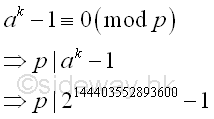
Greatest Common Divisor
Since ak-1 is a very large number, before finding the greatest common divisor of n and ak-1, ak-1 can be raised to the high power modulo n. Imply
Using squarings modulo
| base | number; a=2; k=144403552893600; n=533 |
|---|---|
| ak base 10 | 2144403552893600 |
| ai base 10 | 21 = 21 ก 2 (mod 533) |
| 22 = 22 ≡ 4 (mod 533) | |
| 24 = 42 ≡ 16 (mod 533) | |
| 28 = 162 ≡ 256 (mod 533) | |
| 216 = 2562 ≡ 510 (mod 533) | |
| 232 = 5102 ≡ 529 (mod 533) | |
| 264 = 5292 ≡ 16 (mod 533) | |
| 2128 = 162 ≡ 256 (mod 533) | |
| 2256 = 2562 ≡ 510 (mod 533) | |
| 2512 = 5102 ≡ 529 (mod 533) | |
| 21024 = 5292 ≡ 16 (mod 533) | |
| 22048 = 162 ≡ 256 (mod 533) | |
| 24096 = 2562 ≡ 510 (mod 533) | |
| 28192 = 5102 ≡ 529 (mod 533) | |
| 216384 = 5292 ≡ 16 (mod 533) | |
| 232768 = 162 ≡ 256 (mod 533) | |
| 265536 = 2562 ≡ 510 (mod 533) | |
| 2131072 = 5102 ≡ 529 (mod 533) | |
| 2262144 = 5292 ≡ 16 (mod 533) | |
| 2524288 = 162 ≡ 256 (mod 533) | |
| 21048576 = 2562 ≡ 510 (mod 533) | |
| 22097152 = 5102 ≡ 529 (mod 533) | |
| 24194304 = 5292 ≡ 16 (mod 533) | |
| 28388608 = 162 ≡ 256 (mod 533) | |
| 216777216 = 2562 ≡ 510 (mod 533) | |
| 233554432 = 5102 ≡ 529 (mod 533) | |
| 267108864 = 5292 ≡ 16 (mod 533) | |
| 2134217728 = 162 ≡ 256 (mod 533) | |
| 2268435456 = 2562 ≡ 510 (mod 533) | |
| 2536870912 = 5102 ≡ 529 (mod 533) | |
| 21073741824 = 5292 ≡ 16 (mod 533) | |
| 22147483648 = 162 ≡ 256 (mod 533) | |
| 24294967296 = 2562 ≡ 510 (mod 533) | |
| 28589934592 = 5102 ≡ 529 (mod 533) | |
| 217179869184 = 5292 ≡ 16 (mod 533) | |
| 234359738368 = 162 ≡ 256 (mod 533) | |
| 268719476736 = 2562 ≡ 510 (mod 533) | |
| 2137438953472 = 5102 ≡ 529 (mod 533) | |
| 2274877906944 = 5292 ≡ 16 (mod 533) | |
| 2549755813888 = 162 ≡ 256 (mod 533) | |
| 21099511627776 = 2562 ≡ 510 (mod 533) | |
| 22199023255552 = 5102 ≡ 529 (mod 533) | |
| 24398046511104 = 5292 ≡ 16 (mod 533) | |
| 28796093022208 = 162 ≡ 256 (mod 533) | |
| 217592186044416 = 2562 ≡ 510 (mod 533) | |
| 235184372088832 = 5102 ≡ 529 (mod 533) | |
| 270368744177664 = 5292 ≡ 16 (mod 533) | |
| 2140737488355328 = 162 ≡ 256 (mod 533) | |
| ak base 10 | 2^(140737488355328+ 2199023255552+ 1099511627776+ 274877906944+ 68719476736+17179869184+ 4294967296+ 2147483648+ 268435456+ 33554432+ 4194304+ 2097152+ 1048576+ 524288+ 65536+ 16384+ 8192+ 4096+ 2048+ 512+ 128+ 32) |
| ak base 10 | 2140737488355328*22199023255552*21099511627776*2274877906944* 268719476736*217179869184*24294967296*22147483648*2268435456* 233554432*24194304*22097152*21048576*2524288* 265536*216384*28192*24096*22048*2512*2128*232 |
| ak base 10 | 256*529*510*16*510*16*510*256*510*529* 16*529*510*256*510*16*529*510*256*529*256*529 ≡ 1 (mod 533) |
Imply

The algorithm returns a fail response, because the number n divides ak-1 and n is the greatest common divisor of n and ak-1. Imply
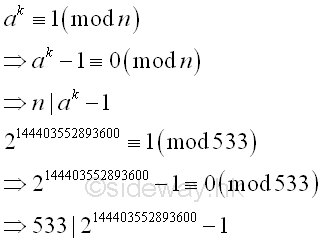
Therefore every prime factor of number n divides ak-1, imply
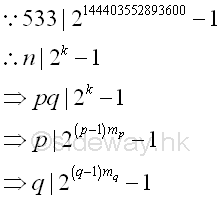
Since the chosen B is much bigger than need, for this case, which is similar to the case in smooth number, k is likely to be the common multiple of p-1 and q-1, imply

Therefore, one way is to select a smaller B so that k is not the common multiple of both p-1 and q-1. Let B=4, Imply
| Integer | B-smooth number | Prime Factors | number |
|---|---|---|---|
| k | 4 | 22*31 = 4*3 | 12 |
Therefore for B=4, k4 or (p4-1)m4 is equal to 12.
Fermat's Little Theorem
let a=2, by Fermat's little theorem, let p be one of the prime factors of n, imply p divides ak-1.
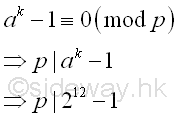
Greatest Common Divisor
Since ak-1 is a very large number, before finding the greatest common divisor of n and ak-1, ak-1 can be raised to the high power modulo n. Imply
Using squarings modulo
| base | number; a=2; k=12; n=533 |
|---|---|
| ak base 10 | 212 |
| ai base 10 | 21 = 21 ก 2 (mod 533) |
| 22 = 22 ≡ 4 (mod 533) | |
| 24 = 42 ≡ 16 (mod 533) | |
| 28 = 162 ≡ 256 (mod 533) | |
| ak base 10 | 28+4 |
| ak base 10 | 28*24 |
| ak base 10 | 16*256 ≡ 365 (mod 533) |
Imply

The greatest common divisor of n and ak-1 is
Using Euclid's algorithm
| ak-1 | n |
|---|---|
| 212-1 | 533 |
| 365-1 | 533 |
| 364 | 533-364=169 |
| 364-2*169=26 | 169 |
| 26 | 169-6*26=13 |
| 26-2*13=0 | 13 |
| 0 | 13 |
Imply
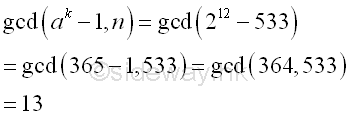
Integer 13, the greatest common divisor of n and ak-1 is also the prime divisor of n. And p-1 is 4-powersmooth.
| Integer | B-smooth number | Prime Factors | number |
|---|---|---|---|
| p-1 | 4 | 22*31 | 12 |
| k | 4 | 22*31 = 4*3 | 12 |
| k/(p-1) | 20*30 | 1 |
Besides, for B=32
| Integer | B-smooth number | Prime Factors | number |
|---|---|---|---|
| p-1 | 4 | 22*31 | 12 |
| q-1 | 8 | 23*30*51*70 | 40 |
| k | 32 | 25*33*52*71*111*131*171*191 231*291*311 | 144403552893600 |
| k/(p-1)(q-1) | 20*32*51*71*111*131*171*191 231*291*311 | 300840735195 |
©sideway
ID: 120500011 Last Updated: 5/17/2012 Revision: 0
Latest Updated Links
- Panasonic SR-CK05 RiceCooker CW-HZ70AA(last updated On 11/17/2025)
- Panasonic Hood Structure Ventilating Fan Blade Diameter: 8in FV-20WH307 CW-HZ70AA(last updated On 11/16/2025)
- Panasonic Window Mount Thermo Ventilator FV-30BW2H CW-HZ70AA(last updated On 11/15/2025)
- Panasonic Inverter PRO Inverter Window Heatpump Air-Conditioner (3/4 HP) CW-HZ70AA(last updated On 11/14/2025)
- Panasonic Inverter Window-Split Type Cooling Only Air-Conditioner (1 HP) CS-U9YWA(last updated On 11/13/2025)
- Panasonic Inverter Steam and Grill_Microwave Oven 27L NN_DS59NB(last updated On 11/12/2025)
- Panasonic KY-C223B Induction Cooker(last updated On 11/11/2025)
- Focus M41 Single lever kitchen mixer 160(last updated On 11/10/2025)
- Focus Single lever basin mixer 230(last updated On 11/9/2025)
- Precision Start Thermostat shower mixer(last updated On 11/8/2025)
- Tempesta 100 Shower Rail Set 3 sprays(last updated On 11/7/2025)

 Nu Html Checker
Nu Html Checker  53
53  na
na  na
na
Home 5
Business
Management
HBR 3
Information
Recreation
Hobbies 8
Culture
Chinese 1097
English 339
Travel 18
Reference 79
Hardware 40![]()
Computer
Hardware 259
Software
Application 213
Digitization 37
Latex 52
Manim 205
KB 1
Numeric 19
Programming
Web 289
Unicode 504
HTML 66
CSS 65
SVG 46
ASP.NET 270
OS 431
DeskTop 7
Python 72
Knowledge
Mathematics
Formulas 8
Set 1
Logic 1
Algebra 84
Number Theory 206
Trigonometry 31
Geometry 34
Calculus 67
Engineering
Tables 8
Mechanical
Rigid Bodies
Statics 92
Dynamics 37
Fluid 5
Control
Acoustics 19
Natural Sciences
Matter 1
Electric 27
Biology 1
